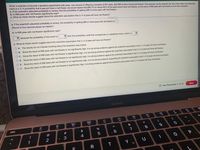
MATLAB: An Introduction with Applications
6th Edition
ISBN: 9781119256830
Author: Amos Gilat
Publisher: John Wiley & Sons Inc
expand_more
expand_more
format_list_bulleted
Question
B. Drop down box 1: no or yes
drop down box 2: less or greater
drop down box 3: 0.95, 0.5. 0.05

Transcribed Image Text:When a scientist conducted a genetics experiments with peas, one sample of offspring consisted of 921 peas, with 698 of them having red flowers. If we assume, as the scientist did, that under these circumstances,
there is a 3 /4 probability that a pea will have a red flower, we would expect that 690.75 (or about 691) of the peas would have red flowers, so the result of 698 peas with red flowers is more than expected.
a. If the scientist's assumed probability is correct, find the probability of getting 698 or more peas with red flowers.
b. Is 698 peas with red flowers significantly high?
c. What do these results suggest about the scientist's assumption that 3/4 of peas will have red flowers?
a. If the scientist's assumed probability is correct, the probability of getting 698 or more peas with red flowers is
.....
(Round to four decimal places as needed.)
b. Is 698 peas with red flowers significantly high?
because the probability of this event is
than the probability cutoff that corresponds to a significant event, which is
c. What do these results suggest about the scientist's assumption that 3/4 of peas will have red flowers?
A. The results do not indicate anything about the scientist's assumption.
B. Since the result of 698 peas with red flowers is not significantly high, it is not strong evidence against the scientist's assumption that 3/4 of peas will have red flowers.
C. Since the result of 698 peas with red flowers is significantly high, it is not strong evidence against the scientist's assumption that 3/4 of peas will have red flowers.
D. Since the result of 698 peas with red flowers is not significantly high, it is strong evidence against the scientisť's assumption that 3/4 of peas will have red flowers.
O E. Since the result of 698 peas with red flowers is not significantly high, it is not strong evidence supporting the scientist's assumption that 3/4 of peas will have red flowers.
O F. Since the result of 698 peas with red flowers is significantly high, it is strong evidence against the scientist's assumption that 3/4 of peas will have red flowers.
OTime Remaining: 01:40:39
Next
MacBook
DD
DII
F10
F9
F8
F7
000
F6
F5
F4
F3
F2
esc
F1
&
!
#3
7
8.
1
2
3
Y
R
14
T
%24
Expert Solution
This question has been solved!
Explore an expertly crafted, step-by-step solution for a thorough understanding of key concepts.
This is a popular solution
Trending nowThis is a popular solution!
Step by stepSolved in 2 steps with 1 images

Knowledge Booster
Similar questions
- P(Administrator | Board-certified) = ? (Round your answer to 4 decimal places.) P(Board-certified | Teacher) = ? (Round your answer to 4 decimal places.) 1st image with the first part. second with part Barrow_forward3%324 es and its sides. 38 38 12 cm 12 cmarrow_forwardEsitmate the percentages 66 2/3 of 3,300arrow_forward
arrow_back_ios
arrow_forward_ios
Recommended textbooks for you
 MATLAB: An Introduction with ApplicationsStatisticsISBN:9781119256830Author:Amos GilatPublisher:John Wiley & Sons Inc
MATLAB: An Introduction with ApplicationsStatisticsISBN:9781119256830Author:Amos GilatPublisher:John Wiley & Sons Inc Probability and Statistics for Engineering and th...StatisticsISBN:9781305251809Author:Jay L. DevorePublisher:Cengage Learning
Probability and Statistics for Engineering and th...StatisticsISBN:9781305251809Author:Jay L. DevorePublisher:Cengage Learning Statistics for The Behavioral Sciences (MindTap C...StatisticsISBN:9781305504912Author:Frederick J Gravetter, Larry B. WallnauPublisher:Cengage Learning
Statistics for The Behavioral Sciences (MindTap C...StatisticsISBN:9781305504912Author:Frederick J Gravetter, Larry B. WallnauPublisher:Cengage Learning Elementary Statistics: Picturing the World (7th E...StatisticsISBN:9780134683416Author:Ron Larson, Betsy FarberPublisher:PEARSON
Elementary Statistics: Picturing the World (7th E...StatisticsISBN:9780134683416Author:Ron Larson, Betsy FarberPublisher:PEARSON The Basic Practice of StatisticsStatisticsISBN:9781319042578Author:David S. Moore, William I. Notz, Michael A. FlignerPublisher:W. H. Freeman
The Basic Practice of StatisticsStatisticsISBN:9781319042578Author:David S. Moore, William I. Notz, Michael A. FlignerPublisher:W. H. Freeman Introduction to the Practice of StatisticsStatisticsISBN:9781319013387Author:David S. Moore, George P. McCabe, Bruce A. CraigPublisher:W. H. Freeman
Introduction to the Practice of StatisticsStatisticsISBN:9781319013387Author:David S. Moore, George P. McCabe, Bruce A. CraigPublisher:W. H. Freeman

MATLAB: An Introduction with Applications
Statistics
ISBN:9781119256830
Author:Amos Gilat
Publisher:John Wiley & Sons Inc

Probability and Statistics for Engineering and th...
Statistics
ISBN:9781305251809
Author:Jay L. Devore
Publisher:Cengage Learning

Statistics for The Behavioral Sciences (MindTap C...
Statistics
ISBN:9781305504912
Author:Frederick J Gravetter, Larry B. Wallnau
Publisher:Cengage Learning

Elementary Statistics: Picturing the World (7th E...
Statistics
ISBN:9780134683416
Author:Ron Larson, Betsy Farber
Publisher:PEARSON

The Basic Practice of Statistics
Statistics
ISBN:9781319042578
Author:David S. Moore, William I. Notz, Michael A. Fligner
Publisher:W. H. Freeman

Introduction to the Practice of Statistics
Statistics
ISBN:9781319013387
Author:David S. Moore, George P. McCabe, Bruce A. Craig
Publisher:W. H. Freeman